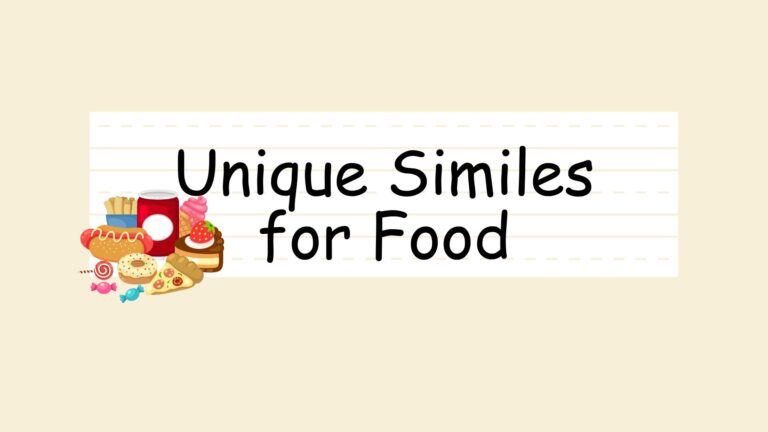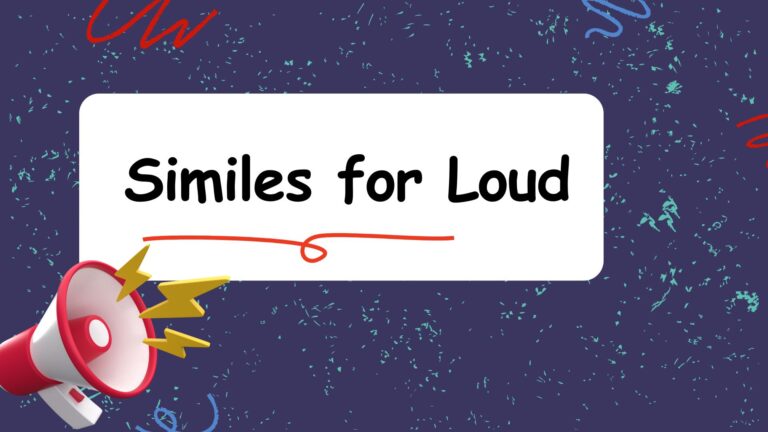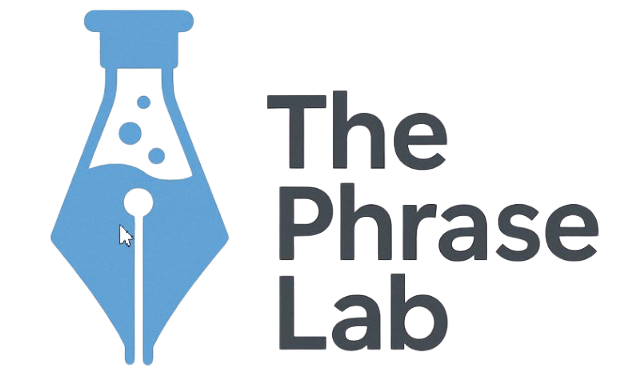
60+ Similes for Summer With Explanation
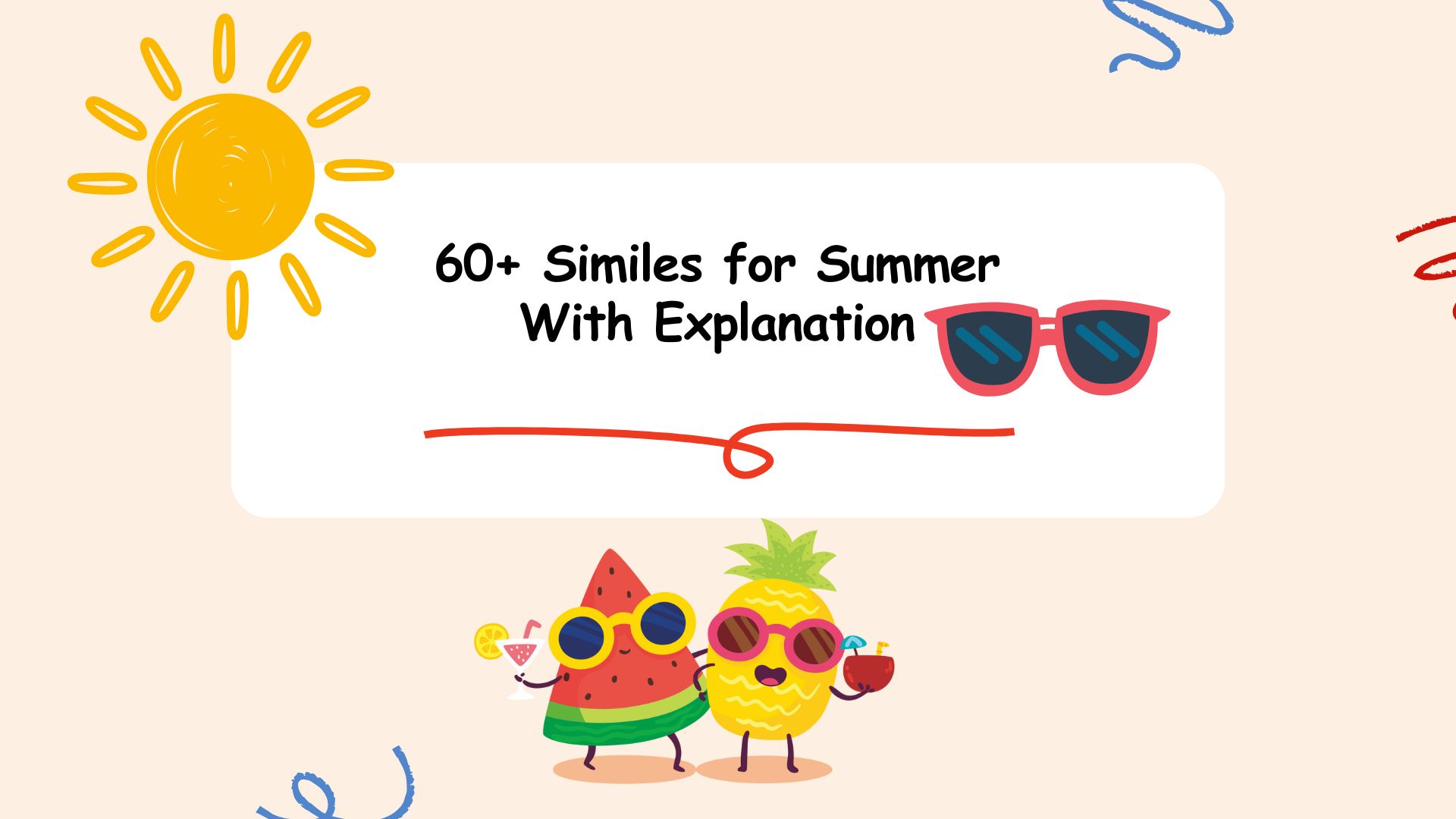
Summer, with its vibrant colors, intense heat, and lively atmosphere, offers a rich tapestry of experiences. Similes, a powerful figure of speech, allow us to paint vivid pictures of these experiences by comparing them to familiar objects, people, or ideas. Mastering the use of similes can significantly enhance your descriptive writing and make your communication more engaging and memorable. This article will explore the definition, structure, types, and similes of summer. Whether you are a student learning the basics or a writer looking to refine your skills, this guide will provide you with the knowledge and practice you need to use similes effectively.
Table of Contents
- Introduction
- Definition of Similes
- Structural Breakdown of Similes
- Types of Similes
- Summer Simile Examples
- Usage Rules for Similes
- Common Mistakes with Similes
- Practice Exercises
- Advanced Topics in Similes
- Frequently Asked Questions
- Conclusion
Definition of Similes
A simile is a figure of speech that directly compares two different things using the words “like” or “as.” The purpose of a simile is to highlight a specific similarity between these two otherwise dissimilar entities. This comparison helps to create a more vivid and understandable image or idea in the reader’s or listener’s mind. Similes are essential tools in descriptive writing, poetry, and everyday conversation, adding depth and color to our language.
Similes are classified as a type of figurative language, which means they deviate from the literal meaning of words to create a specific effect. They function as a bridge between the known and the unknown, allowing us to understand complex or abstract concepts by relating them to something more familiar. In the context of summer, similes can help us capture the essence of the season’s heat, beauty, and energy.
The contexts in which similes can be used are virtually limitless. They appear in literature across genres, from poetry to novels to essays. They are also common in everyday speech, used to describe feelings, experiences, and observations. In advertising, similes are used to make products more appealing by associating them with desirable qualities. Understanding similes enhances both our ability to comprehend language and our capacity to express ourselves creatively.
Structural Breakdown of Similes
The basic structure of a simile consists of three key elements: the **subject**, the **linking word** (either “like” or “as”), and the **object of comparison**. The subject is the thing being described, and the object of comparison is what the subject is being compared to. The linking word establishes the relationship between the two.
For example, in the simile “The sun is like a giant orange,” the subject is “sun,” the linking word is “like,” and the object of comparison is “a giant orange.” This structure allows the reader to visualize the sun’s color and size more vividly.
The order of the elements can sometimes be varied for stylistic effect, but the core components remain the same. For instance, instead of saying “She is as brave as a lion,” one could say “As brave as a lion, she stood her ground.” This variation adds emphasis to the bravery being described. Understanding the structural elements of similes allows for more effective construction and interpretation.
Types of Similes
While all similes share the same basic structure, they can be categorized based on the type of comparison they make and the effect they create. Here are a few common types of similes:
Descriptive Similes
Descriptive similes focus on physical attributes or qualities. They paint a picture using sensory details, such as color, texture, sound, or smell. For example, “The summer breeze was as soft as a whisper” is a descriptive simile that appeals to the sense of touch and sound.
Emotive Similes
Emotive similes express feelings or emotions. They help convey the intensity or quality of a particular emotional state. For example, “He felt as happy as a clam at high tide” is an emotive simile that expresses a feeling of extreme happiness.
Explanatory Similes
Explanatory similes clarify or explain a concept by comparing it to something more familiar. They are often used to simplify complex ideas or make them more understandable. For example, “Learning a new language is like climbing a mountain” is an explanatory simile that conveys the challenges and rewards of language acquisition.
Hyperbolic Similes
Hyperbolic similes use exaggeration to emphasize a particular quality or characteristic. They are not meant to be taken literally but are used for dramatic effect. For example, “The summer heat was as intense as the surface of the sun” is a hyperbolic simile that exaggerates the intensity of the heat.
Summer Simile Examples
To illustrate the use of similes in describing summer, here are several examples categorized by different aspects of the season. These examples demonstrate how similes can be used to evoke specific images and feelings associated with summer.
Similes Describing Summer Weather
The following table provides examples of similes used to describe various aspects of summer weather, such as heat, sunshine, and breezes.
| Simile | Explanation |
|---|---|
| The sun beat down like a blacksmith’s hammer. | Emphasizes the intense heat of the sun. |
| The air was as thick as soup. | Describes the heavy, humid air of summer. |
| The breeze felt like a gentle caress. | Conveys the soothing sensation of a summer breeze. |
| The rain fell like tears from the sky. | Evokes a sense of melancholy during a summer rain. |
| The heat shimmered like a mirage. | Illustrates the visual distortion caused by intense heat. |
| The sky was as blue as a robin’s egg. | Describes the vibrant blue color of the summer sky. |
| The clouds drifted like lazy sheep. | Conveys the slow, peaceful movement of clouds. |
| The humidity clung like a wet blanket. | Emphasizes the uncomfortable feeling of high humidity. |
| The lightning flashed like a camera’s strobe. | Describes the sudden, bright flashes of lightning. |
| The thunder rumbled like a bowling alley in the sky. | Illustrates the loud, echoing sound of thunder. |
| The sunset was as vibrant as a painter’s palette. | Describes the colorful and varied hues of a summer sunset. |
| The morning dew sparkled like diamonds. | Conveys the beauty and brilliance of morning dew. |
| The afternoon sun felt like a warm embrace. | Illustrates the comforting feeling of the sun’s warmth. |
| The evening air was as still as a sleeping lake. | Describes the calm and peaceful atmosphere of a summer evening. |
| The wind howled like a banshee. | Exaggerates the sound of a strong summer storm wind. |
| The heat was as oppressive as a heavy cloak. | Emphasizes the burdensome feeling of extreme heat. |
| The sunshine streamed like liquid gold. | Describes the radiant and precious quality of sunshine. |
| The summer sky was as clear as crystal. | Conveys the pristine clarity of the sky on a summer day. |
| The storm raged like a furious beast. | Illustrates the intensity and power of a summer storm. |
| The sun’s rays pierced through the trees like golden spears. | Describes how sunlight filters through the leaves of trees. |
| The summer air smelled as sweet as honeysuckle. | Relates the smell of summer to the sweet scent of honeysuckle flowers. |
| The summer rain felt like a thousand tiny kisses. | Illustrates the gentle touch of summer rain on the skin. |
| The heat rose from the pavement like an invisible wall. | Describes the heat rising from hot asphalt. |
| The cicadas buzzed like tiny, relentless engines. | Relates the buzzing of cicadas to the sound of engines. |
| The shadows stretched long and thin like reaching fingers. | Describes the appearance of shadows in the evening sun. |
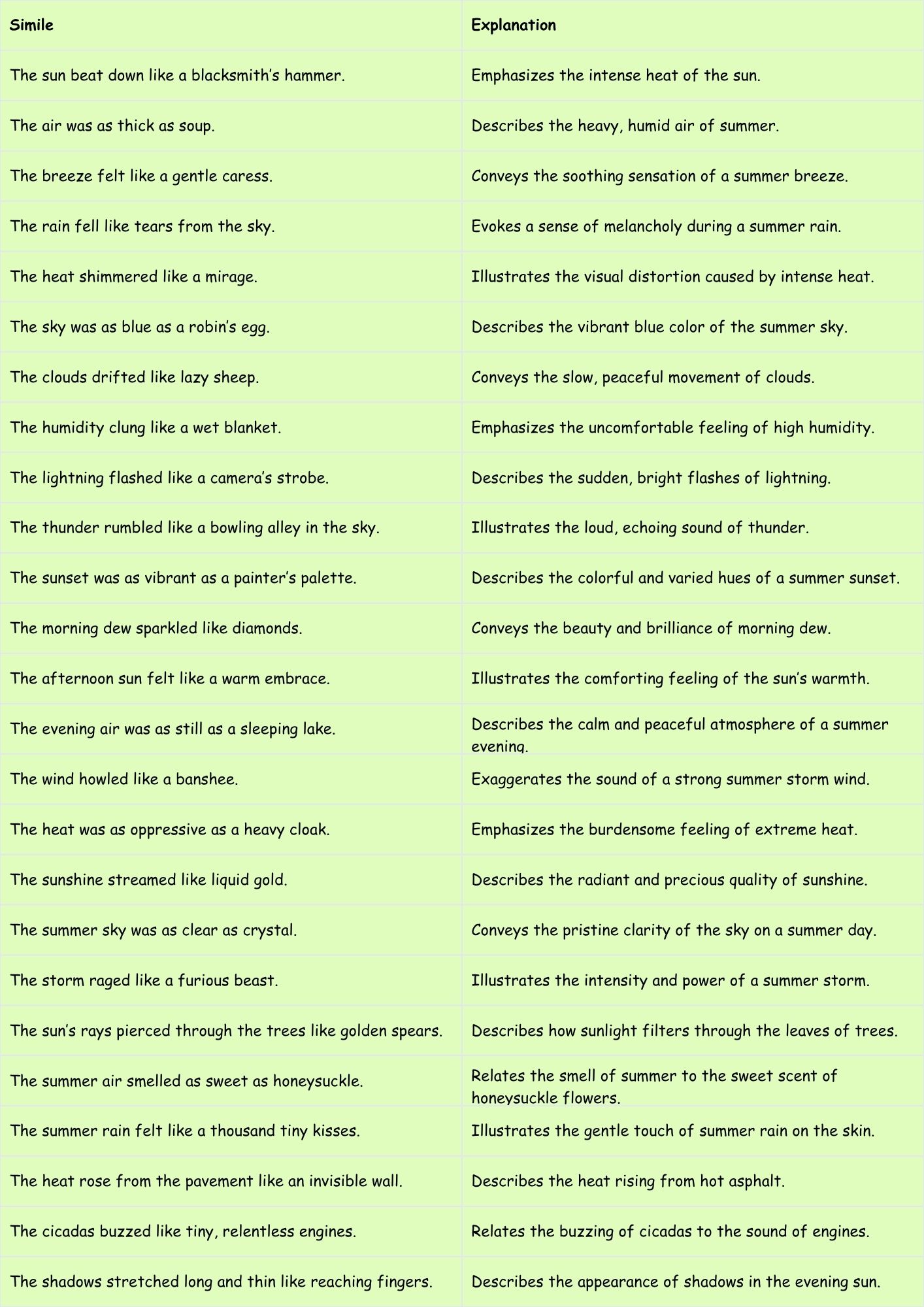
Similes Describing Summer Activities
This table showcases similes used to describe various activities commonly enjoyed during the summer months.
| Simile | Explanation |
|---|---|
| Swimming felt like gliding through silk. | Describes the smooth, effortless feeling of swimming. |
| A day at the beach is like a mini vacation. | Conveys the relaxing and refreshing nature of a beach day. |
| Barbecuing is like a summer ritual. | Emphasizes the traditional and enjoyable aspect of barbecues. |
| Fireflies twinkled like living stars. | Describes the magical appearance of fireflies at night. |
| Eating watermelon is like tasting summer itself. | Conveys the quintessential summer flavor of watermelon. |
| A summer concert is like a burst of energy. | Illustrates the exciting and invigorating atmosphere of a concert. |
| Hiking in the summer is like exploring a green paradise. | Describes the lush and vibrant scenery of summer hikes. |
| Camping under the stars is like sleeping in a planetarium. | Conveys the awe-inspiring experience of stargazing while camping. |
| Riding a bike in the summer is like flying on wheels. | Describes the feeling of freedom and speed while cycling. |
| Picnics are like little celebrations of summer. | Emphasizes the joyful and festive nature of picnics. |
| Playing in the sprinkler felt like being caught in a gentle, joyful storm. | Describes the fun and refreshing experience of playing in a sprinkler. |
| Building sandcastles was like creating fleeting monuments to the sea. | Conveys the temporary and artistic nature of sandcastle building. |
| Watching fireworks is like witnessing a symphony of light. | Illustrates the spectacular and harmonious display of fireworks. |
| A summer road trip is like an adventure waiting to happen. | Emphasizes the excitement and unpredictability of road trips. |
| Sitting on the porch swing is like stepping back in time. | Conveys the nostalgic and relaxing feeling of porch swings. |
| Chasing ice cream trucks is like a quest for frozen treasure. | Describes the eager pursuit of ice cream on a hot day. |
| Lying in a hammock is like floating on a cloud. | Illustrates the relaxing and weightless feeling of lying in a hammock. |
| Catching lightning bugs is like capturing tiny sparks of magic. | Conveys the enchanting experience of catching fireflies. |
| Spending time with family in the summer is like creating memories that last a lifetime. | Emphasizes the importance and enduring nature of family moments. |
| Reading a book under a tree is like escaping to another world. | Describes the immersive and relaxing experience of reading outdoors. |
| Going to a baseball game is like experiencing a slice of Americana. | Relates the experience of attending a baseball game to American culture. |
| Walking barefoot on the grass feels like connecting with the earth. | Illustrates the grounding and natural feeling of walking barefoot. |
| Visiting a farmers market is like discovering a treasure trove of fresh flavors. | Describes the variety and quality of produce at a farmers market. |
| Attending a county fair is like stepping into a world of nostalgia and fun. | Conveys the traditional and enjoyable atmosphere of a county fair. |
| Watching a summer storm roll in is like witnessing nature’s raw power. | Illustrates the awe-inspiring force of a summer thunderstorm. |
Similes Describing Summer Landscapes
The following table offers similes to describe the landscapes and scenery that are characteristic of summer.
| Simile | Explanation |
|---|---|
| Fields of wheat swayed like golden oceans. | Describes the movement and color of wheat fields. |
| The forest was as green as an emerald. | Conveys the vibrant green color of a summer forest. |
| The lake shimmered like a sheet of glass. | Illustrates the smooth, reflective surface of a lake. |
| The mountains stood like silent giants. | Describes the imposing and majestic presence of mountains. |
| The meadow was as colorful as a painter’s palette. | Conveys the variety of colors in a wildflower meadow. |
| The beach stretched out like a ribbon of sand. | Describes the long, narrow shape of a beach. |
| The garden was as lush as a tropical paradise. | Illustrates the abundance and vibrancy of a summer garden. |
| The trees stood like watchful guardians. | Conveys the protective and enduring presence of trees. |
| The river flowed like a silver serpent. | Describes the winding and reflective course of a river. |
| The cornfields stretched as far as the eye could see, like a green sea. | Illustrates the vast expanse and uniform color of cornfields. |
| The sunflowers stood tall and proud, like golden sentinels. | Describes the height and vibrant color of sunflowers. |
| The rolling hills looked like the gentle curves of a sleeping giant. | Conveys the smooth and undulating shape of rolling hills. |
| The vineyards spread across the landscape like a patchwork quilt. | Illustrates the organized and varied appearance of vineyards. |
| The cliffs rose dramatically from the sea, like ancient, weathered castles. | Describes the imposing and aged appearance of cliffs. |
| The desert landscape was as stark and unforgiving as a blank canvas. | Conveys the harsh and barren nature of a desert. |
| The marshland teemed with life, like a hidden world of green. | Illustrates the vibrant and teeming ecosystem of a marsh. |
| The forest canopy formed a ceiling of leaves, like a natural cathedral. | Describes the dense and overarching foliage of a forest. |
| The mountain stream cascaded down the rocks like liquid diamonds. | Conveys the clarity and sparkle of a mountain stream. |
| The wildflowers carpeted the fields like a vibrant, living tapestry. | Illustrates the dense and colorful display of wildflowers. |
| The old farmhouse stood alone, like a forgotten memory. | Describes the solitary and nostalgic presence of an old farmhouse. |
| The winding country road stretched ahead like a ribbon leading to adventure. | Conveys the sense of anticipation and journey associated with a country road. |
| The tall grass swayed in the breeze, like dancers performing a silent ballet. | Illustrates the graceful movement of tall grass in the wind. |
| The orchard trees were laden with fruit, like branches weighed down with jewels. | Describes the abundance and beauty of fruit-laden trees. |
| The vegetable garden grew in neat rows, like a carefully planned city. | Illustrates the organized and productive nature of a vegetable garden. |
| The fields after harvest looked like a stubbled beard on the face of the earth. | Describes the appearance of fields after crops have been harvested. |
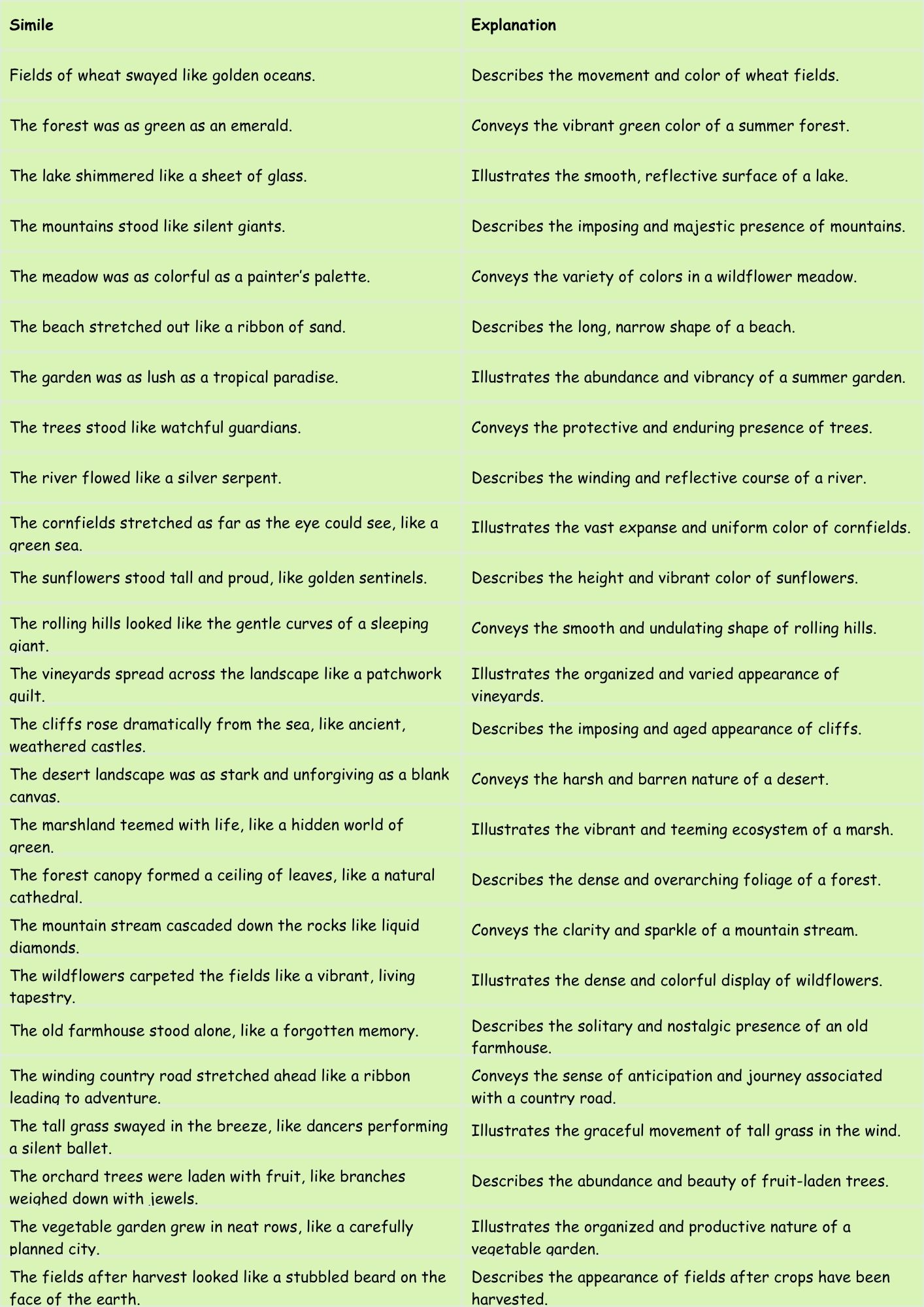
Usage Rules for Similes
Using similes effectively requires an understanding of a few key rules. First, ensure that the comparison is logical and meaningful. The two things being compared should share a recognizable similarity. Second, avoid clichés. Overused similes like “as busy as a bee” or “as strong as an ox” can make your writing sound unoriginal. Strive for fresh and creative comparisons.
Third, consider the context and audience. The simile should be appropriate for the tone and style of your writing. A highly formal piece may not be the best place for a humorous or exaggerated simile. Fourth, be mindful of cultural differences. A simile that resonates with one audience may not be effective or even understandable to another.
Finally, use similes sparingly. Overusing them can make your writing feel forced and artificial. A well-placed simile can add depth and color, but too many can detract from the overall impact. Aim for quality over quantity, and choose similes that enhance rather than distract from your message.
Common Mistakes with Similes
One common mistake is confusing similes with metaphors. While both are figures of speech that make comparisons, similes use “like” or “as,” while metaphors imply a direct comparison without these words. For example, “He is like a lion” is a simile, while “He is a lion” is a metaphor.
Another mistake is using illogical or nonsensical comparisons. The similarity between the two things being compared should be clear and relevant. For example, “The sky is like a sandwich” is not an effective simile because there is no clear or logical connection between the two.
A third mistake is using mixed metaphors and similes. This occurs when you combine two or more incompatible figures of speech. For example, “He was swimming in a sea of troubles, but he kept his head above water like a duck” mixes the metaphor of a “sea of troubles” with the simile of keeping his head “like a duck.”
Here are some examples of common mistakes with similes:
| Incorrect | Correct | Explanation |
|---|---|---|
| He is a lion as brave. | He is as brave as a lion. | Incorrect word order. |
| The sky is like a table. | The sky is like a blue canvas. | Illogical comparison. |
| She was drowning in opportunity, as happy as a clam. | She was overwhelmed with opportunity, as happy as a clam. | Mixed metaphor and simile. |
| The sun is like hot. | The sun is as hot as fire. | Incomplete comparison. |
| He runs like. | He runs like the wind. | Missing object of comparison. |
Practice Exercises
To test your understanding of similes, try the following exercises. Identify the similes in each sentence and explain what two things are being compared. Then, create your own similes using the given prompts.
Exercise 1: Identifying Similes
Identify the similes in the following sentences.
| Question | Answer |
|---|---|
| 1. The summer day was as hot as an oven. | Simile: “as hot as an oven.” Comparison: summer day and oven. |
| 2. Her laughter was like music to his ears. | Simile: “like music to his ears.” Comparison: her laughter and music. |
| 3. The stars twinkled like diamonds in the night sky. | Simile: “like diamonds.” Comparison: stars and diamonds. |
| 4. He felt as light as a feather after the good news. | Simile: “as light as a feather.” Comparison: his feeling and a feather. |
| 5. The old house stood silent as a tomb. | Simile: “as silent as a tomb.” Comparison: old house and tomb. |
| 6. The children ran through the field like wild horses. | Simile: “like wild horses.” Comparison: children and wild horses. |
| 7. The cake was as sweet as honey. | Simile: “as sweet as honey.” Comparison: cake and honey. |
| 8. The clouds were like fluffy cotton balls in the sky. | Simile: “like fluffy cotton balls.” Comparison: clouds and cotton balls. |
| 9. The river flowed as smoothly as silk. | Simile: “as smoothly as silk.” Comparison: river and silk. |
| 10. His anger erupted like a volcano. | Simile: “like a volcano.” Comparison: his anger and a volcano. |
Exercise 2: Creating Similes
Complete the following sentences by adding a simile.
| Question | Possible Answer |
|---|---|
| 1. The summer sun was… | The summer sun was as bright as a spotlight. |
| 2. The beach was… | The beach was like a crowded city on a summer day. |
| 3. The ice cream tasted… | The ice cream tasted as delicious as a dream. |
| 4. The summer breeze felt… | The summer breeze felt like a gentle hand on my face. |
| 5. The fireworks exploded… | The fireworks exploded like colorful flowers blooming in the sky. |
| 6. The lake was… | The lake was as still as a mirror. |
| 7. The crickets chirped… | The crickets chirped like a chorus of tiny singers. |
| 8. The lemonade was… | The lemonade was as refreshing as a cool shower. |
| 9. The garden smelled… | The garden smelled like a bouquet of sweet perfumes. |
| 10. The summer night was… | The summer night was as dark as velvet. |
Advanced Topics in Similes
For advanced learners, exploring the nuances of similes can lead to a deeper understanding of their rhetorical power. One advanced topic is the use of extended similes, where the comparison is developed over several sentences or even paragraphs. This allows for a more detailed and nuanced exploration of the similarities between the two things being compared.
Another advanced topic is the use of implied similes, where the linking word “like” or “as” is omitted, but the comparison is still clear. This can create a more subtle and sophisticated effect. For example, instead of saying “Her eyes were like stars,” one could say “Her eyes, stars in the night.”
Finally, consider the use of similes in different genres and cultural contexts. The effectiveness of a simile can vary depending on the audience and the purpose of the writing. Analyzing how similes are used in different types of texts can provide valuable insights into their versatility and impact.
Frequently Asked Questions
Here are some frequently asked questions about similes:
-
- What is the difference between a simile and a metaphor?
A simile compares two things using “like” or “as,” while a metaphor directly equates two things without these words. For example, “He is like a lion” (simile) vs. “He is a lion” (metaphor).
-
- How can I avoid using clichés in my similes?
To avoid clichés, strive for original and creative comparisons. Think about specific details and sensory experiences that can make your simile more unique and memorable. Brainstorm a variety of comparisons before settling on the one that best captures your meaning.
-
- Can a simile be too long or too complex?
Yes, a simile can be too long or complex if it becomes confusing or distracting. Keep your similes concise and focused on the key similarity you want to highlight. Avoid adding unnecessary details or convoluted language.
-
- Is it okay to use similes in formal writing?
Yes, similes can be used in formal writing, but use them sparingly and choose comparisons that are appropriate for the tone and style of the piece. Avoid overly informal or humorous similes in formal contexts.
-
- How do I choose the right object of comparison for a simile?
Choose an object of comparison that shares a clear and relevant similarity with the subject you are describing. Consider the qualities you want to emphasize and select an object that embodies those qualities in a vivid and understandable way.
-
- What is an extended simile?
An extended simile is a comparison that is developed over several sentences or paragraphs. This allows for a more detailed and nuanced exploration of the similarities between the two things being compared, creating a richer and more impactful image.
-
- How can similes improve my writing?
Similes can improve your writing by making it more vivid, engaging, and understandable. They help readers visualize and connect with your ideas by relating them to familiar objects, experiences, or concepts. They also add depth and color to your language, making your writing more memorable.
-
- Are similes only used in writing?
No, similes are used in both writing and speech. They are a common tool in everyday conversation, storytelling, and public speaking. Using similes effectively can enhance your communication skills in a variety of contexts.
Conclusion
Similes are a valuable tool for enhancing descriptive writing and communication, especially when capturing the essence of summer. By understanding their structure, types, and usage rules, you can effectively use similes to create vivid images and convey emotions. Remember to avoid clichés, choose logical comparisons, and use similes sparingly to maximize their impact. Practice identifying and creating similes to hone your skills and add depth to your language. As you continue to explore the world of similes, you will discover new and creative ways to express yourself and connect with your audience.
By mastering the art of similes, you can transform ordinary descriptions into extraordinary experiences. Whether you are writing poetry, crafting stories, or simply engaging in everyday conversation, the ability to use similes effectively will enrich your language and make your communication more engaging and memorable. So, embrace the power of comparison and let your creativity soar like a kite on a summer breeze.

